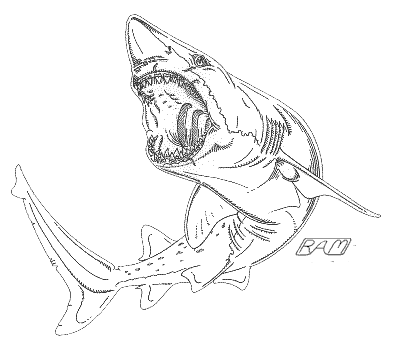Could Megalodon Have Looked
Like a BIG Sandtiger Shark?
Almost all reconstructions of Megalodon are based on the overriding assumption that it was very like the modern White Shark, only more so. But what about the substantial cadre of paleontologists - including Mikael Siverson and David Ward - who believe that the similarities between the teeth of Megalodon and the modern White Shark are superficialities borne of convergence and that the latter definitely is not closely related to or derived from the former? According to these scholars, Megalodon is derived from Otodus and should be placed in the genus Carcharocles. Paleontologist Shelton P. Applegate (who, incidentally, is of the school that regards Megalodon as a member of the genus Carcharodon) has stated that the teeth of Otodus more closely resemble those of a stout-toothed Sandtiger Shark (Carcharias) than they do those of the modern White Shark. If Megalodon descended from Otodus - a creature with Sandtiger-like teeth - rather than resembling a scaled up White Shark, could its body form have been Sandtiger-like, too?
 Among extant lamnoids,
the Sandtiger-like form has evolved in at least four distinct lineages (Mitsukurina,
Carcharias, Odontaspis, and Pseudocarcharias) and may
be symplesiomorphous (ancestral) for this group. In contrast, the classic 'lamnid
body form' — featuring a narrow caudal peduncle supported by stout, lateral
keels, tiny second dorsal and anal fins, and a lunate caudal fin
— seems to
be highly specialized and, as far as we know, appears to have evolved only
once (if one regards the Cetorhinus + Lamnidae clade as monophyletic,
which is strongly supported by morphological and molecular genetic data).
Thus, if the Cretolamna-Otodus-Carcharocles scenario is correct,
Megalodon may well have resembled a heavy-toothed, stocky Sandtiger.
Among extant lamnoids,
the Sandtiger-like form has evolved in at least four distinct lineages (Mitsukurina,
Carcharias, Odontaspis, and Pseudocarcharias) and may
be symplesiomorphous (ancestral) for this group. In contrast, the classic 'lamnid
body form' — featuring a narrow caudal peduncle supported by stout, lateral
keels, tiny second dorsal and anal fins, and a lunate caudal fin
— seems to
be highly specialized and, as far as we know, appears to have evolved only
once (if one regards the Cetorhinus + Lamnidae clade as monophyletic,
which is strongly supported by morphological and molecular genetic data).
Thus, if the Cretolamna-Otodus-Carcharocles scenario is correct,
Megalodon may well have resembled a heavy-toothed, stocky Sandtiger.
There are many who would reject such a heretical notion out-of-hand, but their position would be based more on what they want to be true than on the available evidence. It is an all-too-human foible to allow hope to influence reason. A splendid example of this tendency is provided by those who steadfastly refuse to so much as explore the possibility that the celebrated Tyrannosaurus rex may have been primarily a scavenger rather than the ferocious predator it is traditionally envisioned to be. Paleontologist Jack Horner proposed this interesting though controversial idea in a 1993 popular book. Horner based this notion on T. rex's unusually large olfactory bulbs (the better to smell butyric acid and other pungent breakdown products of rotting carcasses), similar length of its upper and lower leg bones (most running predators have lower leg bones that are much longer than the upper), and the ridiculously small size of its forelimbs (suggesting that if T. rex were to grab large, running prey with its jaws it may lose a substantial percentage of its teeth). If T. rex was a cursorial hunter, each of these points deserves some kind of explanation. Yet virtually every objection to the idea of T. rex as a scavenger have boiled down to, "But look at those fearsome teeth! How could it be a lowly carcass-feeder?". (Personally, I think scavengers have undeservedly gotten a third-rate reputation — despite the lack of respect its practitioners generally receive, scavenging is clearly a highly successful lifestyle. For example, consider the abundance, distribution, and diversity of vultures: they are found in surprising numbers on every continent save Australia and Antarctica and embrace some 21 species in 12 genera and two families. It's tough to argue against success like that.) I suspect that resistance or outright rejection of my playful idea that Megalodon may have resembled a scaled-up Sandtiger Shark will be based more on wishful thinking than compelling physical evidence.
I am by no means convinced megalodon was actually an overstuffed Sand Shark. Offhand, it seems unlikely. But based on the fossil evidence at present, we just don't know.
